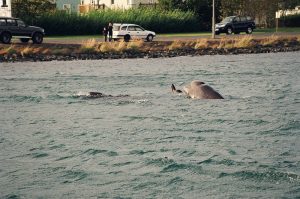Bottlenosed whale
Northern bottlenose whales (Hyperoodon ampullatus) are toothed whales although they do not have many teeth. The bull has only one tooth while the cow has none. They are among the largest toothed whales and the males can reach up to 10 m length. The females are never more than 9 m.
They are similar in size to minke whales, which are among the smallest of baleen whales. These two species are somewhat similar in appearance if only the back is seen but the bottlenose whale is easily distinguished by its bottle nosed face.
Northern bottlenosed whales are found all over the northern North Atlantic Ocean and a closely related species is found in the southern hemisphere, the southern bottlenose whale (Hyperoodon planifrons).
Bottlenose whales are primarily oceanic and rarely seen close to land except beached dead animals. They are one of the deepest-diving whales, known to dive to more than 1 km depth. The major feeding grounds for Northern bottlenose whales are outside the continental shelf, where the depth is more than 1 km. The main food is squid, but other animals, such as fish, sea cucumbers and sea stars, have also been found in their stomachs.
Bottlenose whales become mature at the age of 8-12. The female can bear a calf every 2 years after a 12 month gestation period. The 2-2,5 m long calf is born in April-July. They are probably weaned in the first year but can stay with the mother for much longer. The maximum known age for males is 37 years and 27 years for females.




 This project (EDU-ARCTIC) has received funding from the European Union’s Horizon 2020 research and innovation programme under grant agreement No 710240. The content of the website is the sole responsibility of the Consortium and it does not represent the opinion of the European Commission, and the Commission is not responsible for any use that might be made of information contained.
This project (EDU-ARCTIC) has received funding from the European Union’s Horizon 2020 research and innovation programme under grant agreement No 710240. The content of the website is the sole responsibility of the Consortium and it does not represent the opinion of the European Commission, and the Commission is not responsible for any use that might be made of information contained.